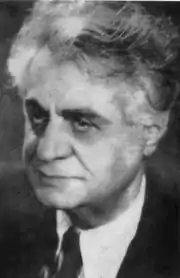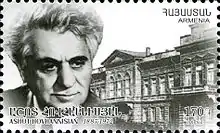Ashot Hovhannisian
Ashot Garegini Hovhannisian (Armenian: Աշոտ Գարգինի Հովհաննիսյան; Russian: Ашот Гарегинович Иоаннисян, Ashot Gareginovich Ioannisyan) was an Armenian Marxist historian,[1][2] theorist[3] and Communist official.
Ashot Hovhannisian | |
|---|---|
Աշոտ Հովհաննիսյան | |
 | |
| First Secretary of the Communist Party of Armenia | |
| In office January 1922 – July 1927 | |
| Preceded by | Askanaz Mravyan |
| Succeeded by | Hayk Ovsepyan |
| 1st Minister of Education of Soviet Armenia | |
| In office December 1920 – 1921 | |
| Preceded by | position established |
| Succeeded by | Poghos Makintsian |
| Personal details | |
| Born | June 17, 1887 Shushi (Shusha), Elisabethpol Governorate, Russian Empire |
| Died | June 30, 1972 (aged 85) Yerevan, Soviet Armenia, USSR |
| Nationality | Armenian |
| Political party | Communist Party of the Soviet Union |
| Alma mater | University of Munich |
| Occupation | Scholar, revolutionary, official |
Life and career
Early life
Hovhannisian was born in Shushi (Shusha) on June 17, 1887.[4][5] He was educated at the local realschule and came under the influence of the social democrats. In 1905 he led an anti-Tsar school strike and handed out flyers demanding Armenian language be mandatory at the school.[4] In September 1906 he moved to Germany, where he began studying philosophy at the University of Jena under philosophers Otto Liebmann and Ernst Haeckel, among others. He partook in union activities and in late 1906 joined the Russian Social Democratic Labour Party (RSDLP).[4] He then continued his education at the University of Halle, where he studied economics, and the University of Munich, where he studied philosophy.[4] He graduated from the University of Munich in 1913 with a doctorate in philosophy.[6]
In 1913 he returned to Shushi, his birthplace, where he taught German and history at the local Armenian seminary. In 1914, at the suggestion of Catholicos Gevorg (George) V he moved to Vagharshapat and began teaching political economy, Latin, German and history at the Gevorgian Seminary, the primary educational institution of the Armenian Apostolic Church. At the seminary, he propagated social-democratic ideas among the students, including Anastas Mikoyan and Aghasi Khanjian, who became prominent communists.[4]
After the February Revolution of 1917, the seminary closed down and Hovannisian returned to Shushi and edited the socialist newspaper Netsuk. In late 1917, he moved to Baku at the request of Stepan Shaumian. He participated in the Baku Commune and became the head of its education department. He also edited the newspaper Banvori khosk («Բանվորի խոսք», The Worker's Word), the Armenian-language organ of the Communist Party's Baku branch. After the fall of the Baku Commune in August 1918, Hovhannisian moved to Astrakhan, then to Moscow by late 1918, where he worked at the Armenian branch of the People's Commissariat for Nationalities of Soviet Russia, then at the Armenian branch at the People's Commissariat for Education. In August 1920 he visited Yerevan to negotiate with the Dashnak government of the First Republic of Armenia.[4]
Soviet period
After the Sovietization of Armenia, Hovhannisian was appointed Minister of Education. In that position, he declared Armenian the official language of Soviet Armenia, fought illiteracy, established a government-run publishing house and Cultural-Educational Institute, organized Yerevan State University, Cultural-Historical Institute, Revolutionary Museum of Yerevan. With Alexander Miasnikian, he persuaded prominent Armenian men of sciences and arts from abroad to move to Soviet Armenia.[4] Under Hovhannisian, the ministry of education confiscated the properties of the Armenian Church in December 1920, including the museums, library and publishing house of the Echmiadzin.[7] He taught Leninism at Yerevan State University between 1921 and 1927.[6]
In January 1922 he was elected first secretary of the Communist Party of Armenia and remained in that position until July 1927. He oversaw the reconstruction of the Armenian economy, promoted education and science, agriculture and industry.[4] He was dismissed for "his underestimation of the dangers of Trotskyism and specifism (independent Marxism)."[8]
In July 1927 he moved to Leningrad, where he worked at the State Public Library (now National Library of Russia) for a year, then was invited to work in Moscow, at the Marxism-Leninism Institute in 1928–31. Between 1931 and 1934 he was vice-director of the Institute of Nationalities of the USSR and in 1934–35 at the State Academy of Material Culture History as head of the Moscow branch and in 1935–37 worked as vice-director of the USSR Institute of History.[4]
During the Great Purge under Stalin, Hovhannisian was fired from his job in July 1937, then aged 50, and arrested on trumped-up charges.[4] He was jailed first in Moscow and Yerevan, then was exiled to the Komi Republic, then to Yangiyoʻl in Uzbekistan. He was permitted to return to Armenia in 1943 with the condition not to live in Yerevan. Consequently, he resided in Kirovakan (now Vanadzor) and was allowed to work at the institutes of history and literature of the Armenian Academy of Sciences remotely, between 1943 to 1954.[4]
Beginning in 1954, he worked at the Institute of History of the Armenian Academy as a senior researcher and headed the new history department from 1961.[6] In 1955 he defended his doctoral thesis and in 1960 was elected a full member (academician) of the Armenian Academy.[4]
Research
Hovhannisian's doctoral thesis at the University of Munch was devoted to Israel Ori and titled Israel Ory und die armenische Befreiungsidee, which was published in German in 1913.[10][9] While teaching at the Gevorgian Seminary in Echmiadzin in 1914–17, Hovhannisian began researching at the library and manuscript repository of the Armenian Church. His papers on medieval Armenian history and Armenian-Russian relations were published in Ararat, the journal of the church.[4][6] His other notable works include The Question of the Armenian-Russian Orientation («Հայ-ռուս օրիենտացիայի ծագման խնդիրը», 1921), Nalbandian and His Time («Նալբանդյանը և նրա ժամանակը», 1955, 1956), Episodes from the History of the Armenian Liberation (1957, 1959), and Armenian-Russian Relations in the First Three Decades of the 18th Century («Հայ-ռուսական հարաբերությունները 18-րդ դարի առաջին երեսնամյակում», 1967).[6]
Recognition

Hovhannisian was one of the most significant Armenian historians of the 20th century. His interest in the history of Armenia’s modernization was not a matter of purely academic interest, but a practical one.[11] A Soviet dissident publication note that "[r]ather than as a political figure, he is better known as an intellectual possessing a high degree of originality, which is a rare phenomenon within the ranks of the Communist Party."[12]
Hovhannisian became a full member (academician) of the Armenian Academy of Sciences in 1960.[5] His obituary was signed by Soviet Armenian leader Anton Kochinyan, long-time top Soviet official Anastas Mikoyan, World War II hero Ivan Bagramyan, and numerous scientists and scholars, including Viktor Ambartsumian, Sergey Mergelyan, Andronik Iosifyan, Boris Piotrovsky.[13] His bronze bust stands at the central campus of Yerevan State University.[6]
The Ashot Johannissyan Research Institute in the Humanities was established in 2014.[14]
Awards
Hovhannisian was named an Honored Scientist of the Armenian SSR in 1961,[5] awarded the Order of Lenin in 1967,[6] and the State Prize of the Armenian SSR posthumously in 1985.[5]
References
- Voskanian, Ashot (2016). "On Two Factors of National Identity: Orientation and Social Structure of Society". Wisdom. International Research Institute for Metaphilosophy, Transformational Logic and Theory of Argumentation at Khachatur Abovian Armenian State Pedagogical University. 7 (2): 111–116. doi:10.24234/wisdom.v2i7.143. ISSN 1829-3824.
As a Marxist-historian he underlined the common social struggle of the Armenians and other exploited neighboring nations...
- Azatyan, Vardan (2015). "More Alive than the Living: The Historical Time of the Revolution" (PDF). American University of Beirut. p. 32.
I discuss the theory of history, as developed by Armenian Marxist historian Ashot Johannissyan in the first part of the twentieth century...
- Problems of the Peoples of the USSR. League for the Liberation of the Peoples of the USSR, 1961, Issues 8-16, p. 37 "He was also accompanied by his adviser, the well-known Armenian Communist historian and Marxist theorist Ashot Ovanesyan..."
- Sarukhanyan, Norayr (2012). "Ակադեմիկոս Աշոտ Հովհաննիսյանի կյանքը և պատմագիտական ժառանգությունը (Ծննդյան 125-ամյակի առթիվ) [Academician Ashot Hovhannissyan's Life and Historiographical Heritage (to the 125th birth anniversary)]". Patma-Banasirakan Handes (in Armenian) (2): 271–276.
- "Հովհաննիսյան Աշոտ Գարեգինի [Hovhannisyan Ashot Garegini]". sci.am (in Armenian). National Academy of Sciences of Armenia. Archived from the original on 29 January 2021.
- "Աշոտ Հովհաննիսյան [Ashot Hovhannisyan]". ysu.am (in Armenian). Yerevan State University. Archived from the original on 29 January 2021.
- Sukiasyan, H. (2014). "Եկեղեցու սեփականության բռնագրավումը Խորհրդային Հայաստանում (1920 թ. դեկտեմբեր – 1921 թ. փետրվար) [Expropriation of church in Soviet Armenia (December 1920-February 1921)]". Lraber Hasarakakan Gitutyunneri (in Armenian) (1): 95–102.
- de Baets, Antoon (2002). Censorship of Historical Thought: A World Guide, 1945-2000. Greenwood Publishing Group. p. 524. ISBN 9780313311932.
- "Հովհաննիսյան Աշոտ Գարեգինի (1887-1972) [Hovannisian Ashot Garegini (1887-1972)]". greenstone.flib.sci.am (in Armenian). Armenian National Academy of Sciences. Archived from the original on 6 February 2021.
- Johannissjan, Aschot (1913). Israel Ory und die armenische Befreiungsidee (in German). Munich: Müller & Sohn.
- Harutyunyan, Angela. "Art History and the Challenge of Apprehending the Familiar: A Conversation with Vardan Azatyan". artmargins.com. ARTMargins. Archived from the original on 30 January 2021.
- Mikirtchian, Levon (1962). "Noteworthy Soviet Armenian Publications". Studies on the Soviet Union. Munich: Institute for the Study of the USSR. 2: 143.
- Editorial (1972). "Աշոտ Գարեգինի Հովհաննիսյան [Ashot G. Hovhannisian]". Patma-Banasirakan Handes (in Armenian) (2): 292–294.
- "Mission and Goals". johannissyan.am. Ashot Johannissyan Research Institute in the Humanities. Archived from the original on 6 February 2021.
